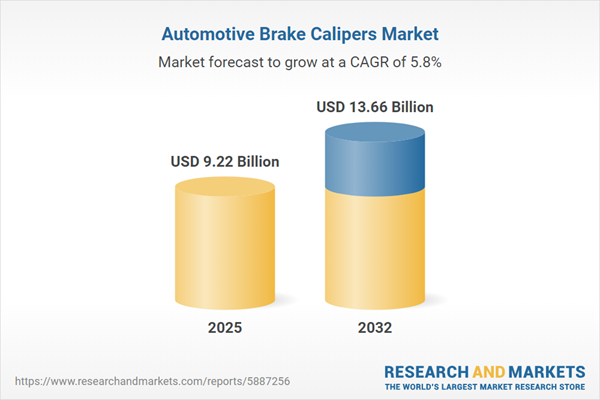Speak directly to the analyst to clarify any post sales queries you may have.
The automotive brake calipers market is evolving rapidly as manufacturers respond to technology advances, stricter regulations, and heightened supply chain complexity. Senior executives require precise market intelligence to anticipate industry shifts and create agile business strategies in this dynamic sector.
Market Snapshot: Automotive Brake Calipers Market Size & Growth
The global automotive brake calipers market is valued at USD 8.70 billion in 2024, with projections indicating a rise to USD 13.66 billion by 2032 at a CAGR of 5.79%. Growth is primarily fueled by continuous advancements in braking technologies, changes in international regulations, and enhancements in manufacturing productivity. The trend toward vehicle electrification is driving demand for sophisticated, high-performance calipers, while the push for sustainability and compliance is shaping strategic responses across the industry. Value chain participants are increasingly focusing on these evolving requirements to strengthen their market positions and optimize operational performance.
Scope & Segmentation: Strategic Dimensions for Automotive Brake Calipers Market
This report delivers a robust decision-making resource, designed for senior leaders seeking operational clarity and strategic segmentation within the automotive brake calipers industry. Core focus areas include:
- Vehicle Types: Evaluates electric vehicles, passenger cars, and both light and heavy commercial vehicles, with consideration of unique compliance, safety, and engineering requirements in each segment.
- Electric Vehicle Segments: Considers battery electric, hybrid, and plug-in hybrids, examining the integration of brake-by-wire and regenerative braking systems in diverse powertrain architectures.
- Product Designs: Assesses fixed and floating calipers, distinguishing between monoblock and two-piece construction and reviewing single or dual piston arrangements for impacts on assembly and performance.
- Sales Channels: Analyzes dealer, OEM, distributor, and digital/e-commerce channels in relation to inventory control, market access, and customer interaction models.
- Materials: Investigates application of aluminum alloys, cast iron, and composites, weighing durability, lifecycle cost, and compliance factors crucial to product selection.
- End-Use Applications: Looks at OEM integration in new vehicles and aftermarket replacement, highlighting supplier collaboration and the necessity of robust parts and service networks.
- Regions: Reviews trends and operational considerations across the Americas, Europe, Asia-Pacific, and Middle East & Africa, acknowledging local consumer expectations and regional supply chain challenges.
- Featured Companies: Profiles major players such as Brembo S.p.A., Continental AG, ZF Friedrichshafen AG, Robert Bosch GmbH, Aisin Seiki Co., Ltd., Akebono Brake Industry Co., Ltd., Nissin Kogyo Co., Ltd., Mando Corporation, Hitachi Astemo, Ltd., and JTEKT Corporation, with attention to growth strategies and innovation trajectories.
- Technologies: Explores developments in regenerative braking, embedded electronics, sensor integration, digital diagnostics, and evolving caliper architectures vital to future industry readiness.
Key Takeaways for Senior Decision-Makers
- Aligning product development with trends in electrification and digitalization can help anticipate both regulatory shifts and evolving competitive environments.
- Utilizing lightweight and composite materials enhances operational efficiency and flexibility, particularly in jurisdictions with progressive or shifting industry standards.
- Pursuing sustainability initiatives and leveraging recycled content in calipers support resilient supply chains, while strengthening supplier partnerships and ensuring ongoing availability.
- Integrating digital procurement processes and omni-channel sales strategies equips organizations to rapidly adjust inventories and enhance customer support responsiveness.
- Investing in advanced smart braking systems and sensor-enabled platforms positions companies to meet new safety standards and performance priorities established by both regulators and end-markets.
- Customizing strategies to address specific regulatory and consumer expectations in varied global regions helps maintain business agility and compliance effectiveness.
Tariff Impact and Supply Chain Adjustments
With adjustments in U.S. steel and aluminum tariffs, automotive brake caliper manufacturers are reassessing supply chains to control cost exposure and boost resilience. Strategies such as near-shoring, forming new regional supplier partnerships, and leveraging tariff-exempt production zones are proving effective for mitigating risks. These adaptations are driving deeper supplier consolidation and streamlining operations, which bolsters consistency in product quality across regions and enables companies to stay responsive to fluctuating policy environments.
Methodology & Data Sources
Analysis draws from recent executive interviews, assessment of specialized trade sources, and systematic reviews of company reports. Industry event participation and rigorous benchmarking against independent third-party data enhance the reliability of findings for strategic planning.
Why This Report Matters for Industry Leaders
- Equips organizations with actionable insights for market strategy, risk management, and adaptive supply chain optimization in evolving industry conditions.
- Supports senior decision-makers in identifying operational improvement areas and building resilient supplier networks across changing market scenarios.
- Enables executives to confidently address regulatory, technological, and market competition challenges using verified, context-rich intelligence.
Conclusion
This report empowers executives to proactively respond to regulatory developments, build flexible supply strategies, and harness technology shifts shaping the automotive brake calipers industry.
Additional Product Information:
- Purchase of this report includes 1 year online access with quarterly updates.
- This report can be updated on request. Please contact our Customer Experience team using the Ask a Question widget on our website.
Table of Contents
3. Executive Summary
4. Market Overview
7. Cumulative Impact of Artificial Intelligence 2025
Companies Mentioned
The companies profiled in this Automotive Brake Calipers market report include:- Brembo S.p.A.
- Continental AG
- ZF Friedrichshafen AG
- Robert Bosch GmbH
- Aisin Seiki Co., Ltd.
- Akebono Brake Industry Co., Ltd.
- Nissin Kogyo Co., Ltd.
- Mando Corporation
- Hitachi Astemo, Ltd.
- JTEKT Corporation
Table Information
| Report Attribute | Details |
|---|---|
| No. of Pages | 182 |
| Published | November 2025 |
| Forecast Period | 2025 - 2032 |
| Estimated Market Value ( USD | $ 9.22 Billion |
| Forecasted Market Value ( USD | $ 13.66 Billion |
| Compound Annual Growth Rate | 5.7% |
| Regions Covered | Global |
| No. of Companies Mentioned | 11 |









